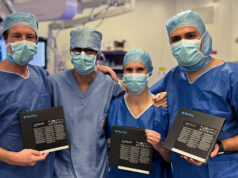
On 19 March, the first patient was included in the BeGraft fenestrated endovascular aneurysm repair (FEVAR) study investigating the Bentley BeGraft peripheral balloon expandable covered stent in complex aortic aneurysms.
The patient was referred for FEVAR with a 6cm juxtarenal abdominal aortic aneurysm, explained the coordinating investigator and study lead, Eric Verhoeven (General Hospital Nuremberg, Paracelsus Medical University, Nuremberg, Germany). “This patient has an absolute indication due to the diameter and we cannot use standard EVAR to seal below the renal arteries because there is no sealing zone available,” he explained.
A further two patients are planned in the next week, added Verhoeven, pleased to announce the launch of the open-label BeGraft FEVAR study.
The study aims to investigate the safety and performance of the BeGraft peripheral stent graft system as a bridging stent in FEVAR for complex aortic aneurysms. The study, which is approved by the German competent authority BfArM, is being run in collaboration with Bentley and the Foundation for Cardiovascular Research and Education (FCRE).
Participating centres in the study include Nuremberg, Munster, Munich, Regensburg, Aachen, Stuttgart, and Giessen, all in Germany. A total of 100 patients will be included to generate data on approximately 250–300 BeGrafts in fenestrations. Recruitment is deemed to take 12 months, with 24 months follow-up.
The main outcomes will be technical success (successful introduction and deployment), bridging stent patency at 12 months, as well as the absence of procedure-related complications and bridging stent-related endoleaks at 12 months. Overall clinical outcomes including 30-day mortality, and health-related quality of life will also be assessed alongside adverse events.













